Stroke Post Processing Software Market Size
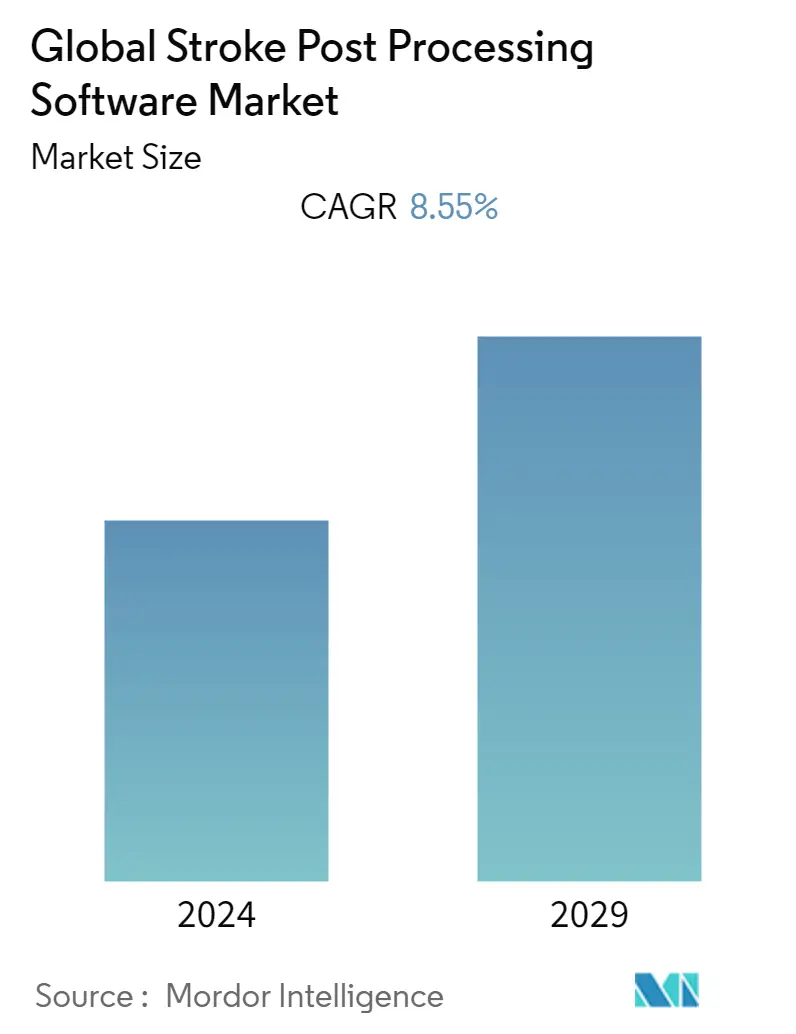
| Study Period | 2019 - 2029 |
| Base Year For Estimation | 2023 |
| Forecast Data Period | 2024 - 2029 |
| CAGR | 8.55 % |
| Fastest Growing Market | Asia-Pacific |
| Largest Market | North America |
Major Players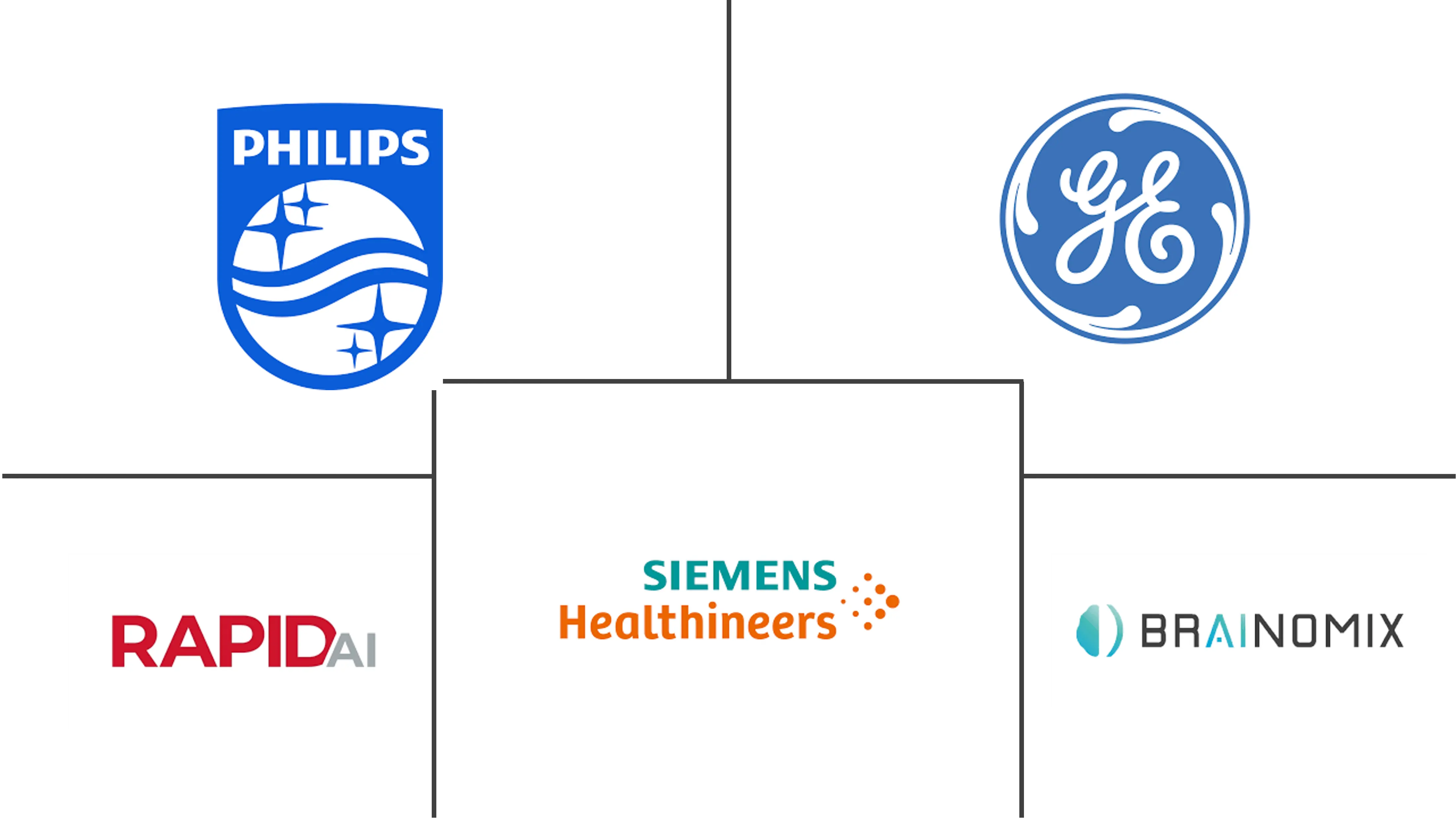
*Disclaimer: Major Players sorted in no particular order |
Stroke Post Processing Software Market Analysis
The Stroke Post Processing Software Market is projected to register a CAGR of 8.55% during the forecast period (2022-2027).
During the COVID-19 pandemic, most of the hospital-based care was shifted to caring for coronavirus-infected patients, putting a transient and slight dent in growth. However, as more COVID patients suffered strokes and other brain-related issues, the demand for stroke post-processing software grew. Due to the sensitive nature of the stroke, however, market conditions recovered quickly. Frontline workers can now make better treatment decisions because of the availability of helpful post-stroke management software. AI-Artificial intelligence-driven stroke management software has seen a considerable surge in popularity because of technological improvements. Reduced hospital admissions of stroke patients were noted during the initial COVID-19 outbreak. It was because people were afraid of infection during a period of segregation and lockdown. A decline in acute stroke hospital admissions has been recorded in many regions, indicating that many patients with mild and severe strokes are also avoiding hospitalization. According to data from the National Institute of Health-2020, patient admission, treatment, and discharge volumes for acute stroke therapy in central and south Texas have reduced dramatically since COVID-19-related lockdown orders were issued.
Stroke management systems and software are in higher demand as the number of strokes rises. According to the Centers for Disease Control and Prevention (CDC), stroke is expected to account for one in every six deaths in the United States by 2020. The software systems provide better treatment outcomes for stroke victims. The AI-Artificial intelligence-based approach aids stroke specialists in detecting major vascular occlusions, allowing patients to be referred and transferred more quickly. The use of stroke post-processing software allows for the creation of more efficient pathways, faster treatment decisions, and improved patient outcomes. Technological improvements, particularly in the realm of healthcare IT solutions, have considerably improved software adoption by healthcare professionals while also lowering the likelihood of post-stroke problems.
The stroke post-processing software generates more detailed images with synchronized data, assisting in the diagnosis of the stroke's effect or progression and allowing physicians to make more rapid clinical judgments. As a result, investing in it to improve quality and updates can have a huge impact on market growth. For instance, Hospital software ViewPoint 6 Direct Connect by GE Healthcare helps reduce dictation by auto-populating ultrasound measurements and report details directly into the radiology reporting system and makes the physicians' work easier. According to the Centers for Disease Control and Prevention-2022, a stroke occurs every 40 seconds in the United States. Someone dies of a stroke every 3.5 minutes. In both developed and emerging nations, government policies that promote the overall adoption of healthcare IT solutions to improve healthcare outcomes operate as a primary reinforcing factor for the industry. Increased healthcare awareness, an increase in the frequency of diabetes, an increase in the number of tobacco users, and an increase in the senior population are all driving market expansion.
Furthermore, technical developments in stroke detection and treatment add to the market's growth. Artificial intelligence and machine learning are projected to become commonplace as the healthcare business continues to rely on technological breakthroughs. More sophisticated ways of detecting, diagnosing, and treating stroke patients are expected because of this. This will force service providers to implement highly advanced stroke post-processing software. However, high diagnostic and treatment costs, as well as a lack of reimbursement regulations, are projected to limit market expansion. On the other hand, continuous R&D in the field of stroke management is likely to provide the profitable potential for market expansion. Artificial intelligence and other technological developments have become more widely adopted across important healthcare settings as their penetration has increased. All the factors contribute to accelerating the market growth during the forecast period.
Stroke Post Processing Software Market Trends
This section covers the major market trends shaping the Stroke Post Processing Software Market according to our research experts:
The MRI Segment is Expected to Hold a Major Market Share for Modality in the Stroke Post Processing Software Market
A stroke is a debilitating ailment that has a significant impact on a patient's quality of life, especially if it is not treated promptly. Early detection of a stroke can lessen the likelihood of the patient surviving with a handicap. The head, including the tissue and blood vessels, can be seen clearly with MRI imaging. Magnetic fields and radiofrequency pulses are used in an MRI to reveal any alterations in the brain. The market is divided into CT scan and MRI segments based on modality. Magnetic resonance imaging (MRI) is a useful diagnostic tool for detecting disorders such as lesions in the spine, cancers, and strokes that affect the blood vessels and brain. The rising prevalence of lesions in the spine, cancers, and stroke disorders is likely to contribute significantly to market expansion. The increasing demand for speedy and effective diagnostic treatments is projected to drive MRI machine usage. These MRI equipment are being installed in several nations. According to the National Health Service updates from December 2021, there were 40.3 million imaging tests reported in England in the 12 months from September 2020 to August 2021. Of these, 3.22 million imaging tests were reported to have taken place in August 2021. In August 2021, Plain Radiography (X-ray) was most common (1.6 million), followed by Diagnostic Ultrasonography (Ultrasound, 0.72 million), Computerized Axial Tomography (CT Scan, 0.49 million), and Magnetic Resonance Imaging (MRI, 0.29 million).
The MRI industry is growing because of advancements in diagnostic approaches such as open MRI, visualization software, and superconducting magnets. The majority of the recent advancements in MRI technology have been in software. These software innovations make contrast scans faster and the imaging procedure easier. Growing MRI technology enables the fast detection and diagnosis of stroke and helps in proper management. Diffusion and diffusion tensor imaging with tractography, neuroimaging comprising MR spectroscopy, perfusion imaging, and functional imaging employing the bold technique are projected to drive market growth throughout the forecast period. Moreover, the market is predicted to increase due to the increasing development of intraoperative MRI and its use in various applications such as neurosurgery throughout the forecast period.
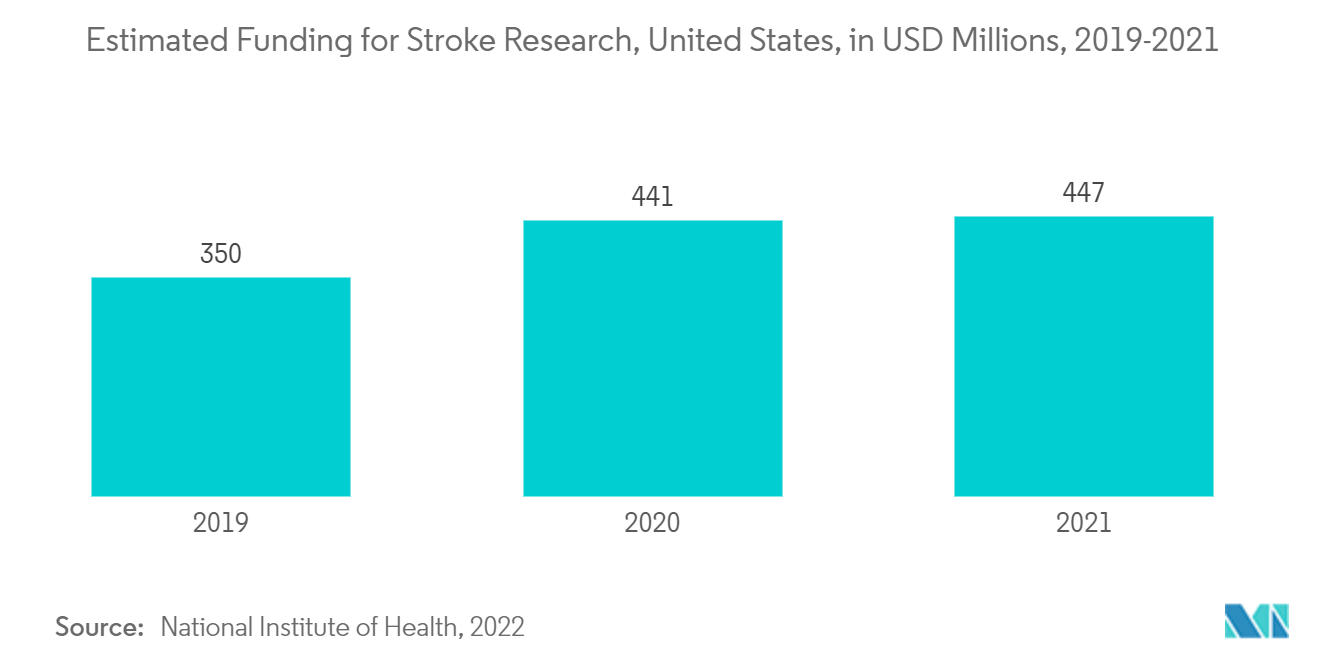
North America is Expected to Hold a Significant Share in the Market and Expected to do Same in the Forecast Period
North America is expected to account for a sizable portion of the market. This is due to an increase in the incidence of chronic diseases like diabetes, an increase in demand for stroke management devices, the availability of advanced healthcare facilities with trained medical professionals, an increase in the number of R&D activities with a large presence of key players, and an increase in government investment in the healthcare system. The rising prevalence of chronic disorders, particularly neurological ailments, in this region drives up demand for imaging analysis. Throughout the predicted period, the region is likely to maintain its supremacy.
During the projected period, technological advancements combined with an increase in the incidence of chronic illnesses are expected to drive market expansion. Factors such as the increased stroke prevalence, massive patient population expansion, and supportive government investments in the creation of improved healthcare facilities in the region. Stroke affects more than 795,000 people in the United States each year, according to the United States Department of Health and Human Services 2020. As a result, hospitals and specialized institutions in the United States and Canada are increasingly using stroke post-processing software to help detect aneurysms and other vascular diseases.
The market is expected to benefit from the increased usage of artificial intelligence in the diagnosis and treatment of strokes. The market is expected to rise due to the introduction of newer technologies for patient data processing. By establishing a disease pattern from the tailored data, the processed patient data can focus on a specific group of people at risk of acquiring diseases. Market companies can expand their presence in developing countries by delivering sustainable healthcare solutions, making their products and services more accessible, and addressing digital difficulties.
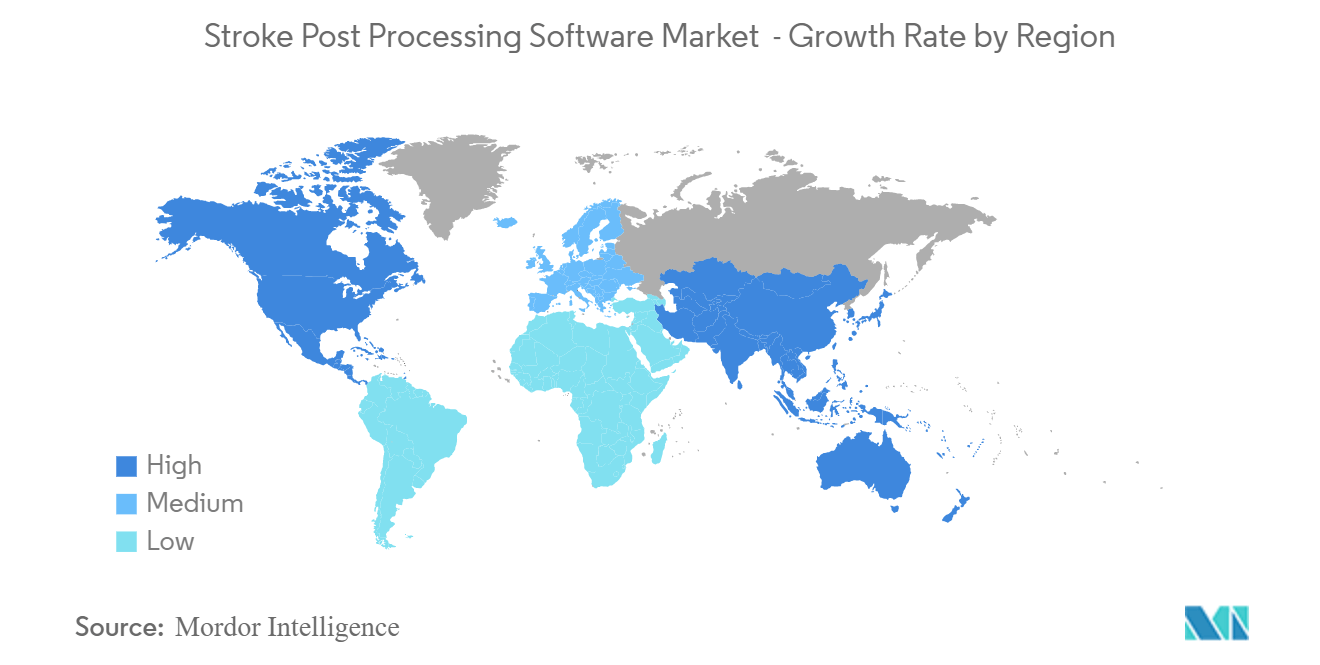
Stroke Post Processing Software Industry Overview
The Stroke Post Processing Software Market is fragmented and competitive and consists of several major players. In terms of market share, a few of the major players are currently dominating the market. Some of the companies which are currently dominating the market are Brainomix, Constant Therapy, Cozi, General Electric Company, Koninklijke Philips NV, Medisafe, RAPIDAI, Siemens Healthineers, Tactus Therapy Solutions Ltd, and Viz.ai Inc.
Stroke Post Processing Software Market Leaders
-
General Electric Company
-
Koninklijke Philips NV
-
Siemens Healthineers
-
RAPIDAI
-
Brainomix
*Disclaimer: Major Players sorted in no particular order
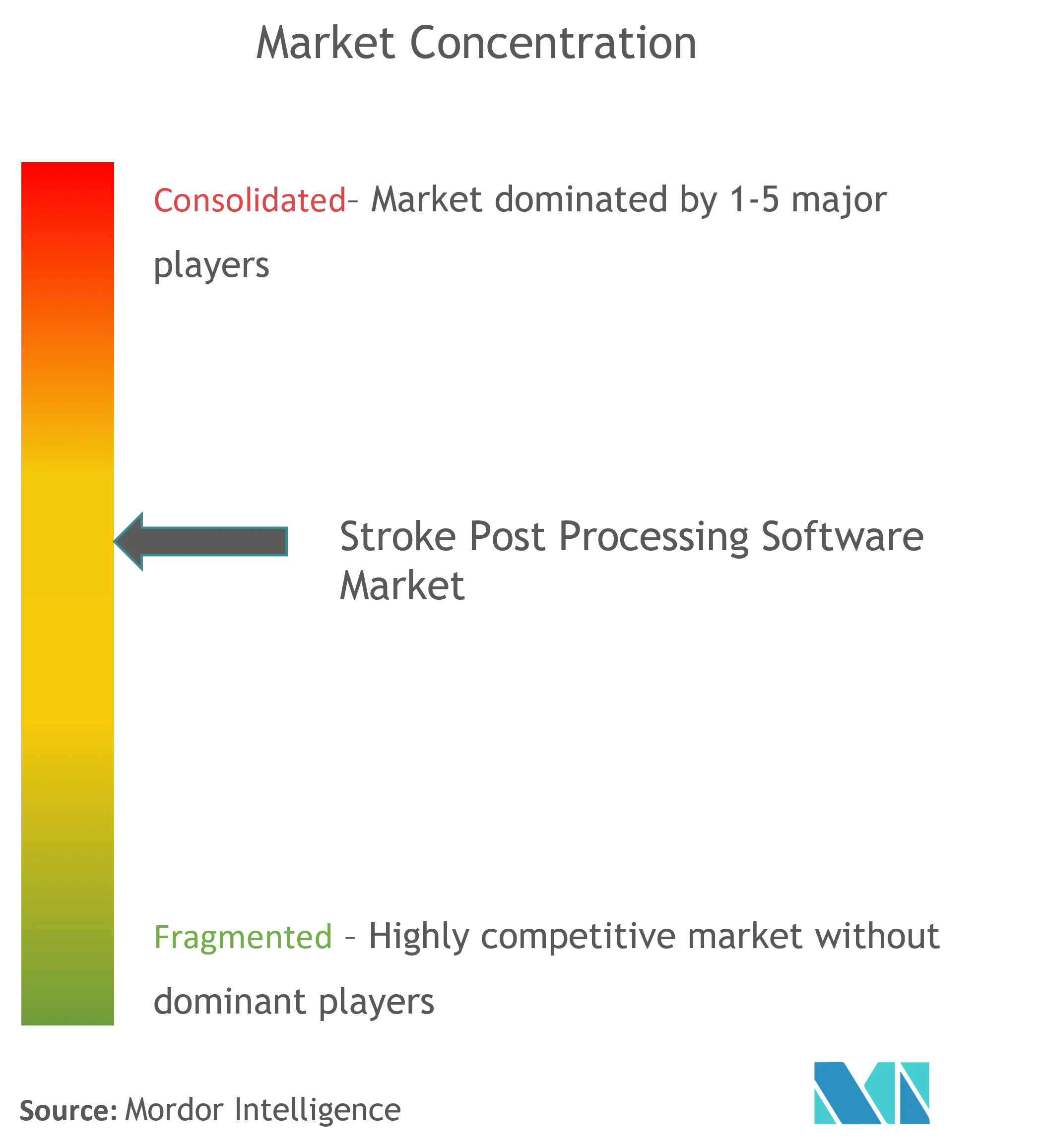
Stroke Post Processing Software Market News
- In January 2022, Brainomix launched e-Stroke 11, the latest version of the company's award-winning AI-powered stroke imaging platform, which will enhance stroke network communications by allowing physicians to quickly and securely access, review and share images and patient data, send messages, make calls directly from the e-Stroke Mobile App, and flag patients eligible for thrombectomy - all designed to further optimize workflow, facilitating faster transfer and treatment decisions.
- In July 2021, Royal Philips announced a strategic partnership agreement with NICO.LAB, a MedTech stroke care company. Philips accelerates stroke diagnosis and treatment with expanded integrated solutions and strategic partnerships.
Stroke Post Processing Software Market Report - Table of Contents
1. INTRODUCTION
- 1.1 Study Assumptions and Market Definition
- 1.2 Scope of the Study
2. RESEARCH METHODOLOGY
3. EXECUTIVE SUMMARY
4. MARKET DYNAMICS
- 4.1 Market Overview
-
4.2 Market Drivers
- 4.2.1 Rapid Technological Advancement
- 4.2.2 Increased Government Funding towards Genomics
- 4.2.3 Growing Adoption of Personalized Medicine
-
4.3 Market Restraints
- 4.3.1 Lack of Skilled Labor
- 4.3.2 High Cost of the Instruments
-
4.4 Porter's Five Force Analysis
- 4.4.1 Threat of New Entrants
- 4.4.2 Bargaining Power of Buyers/Consumers
- 4.4.3 Bargaining Power of Suppliers
- 4.4.4 Threat of Substitute Products
- 4.4.5 Intensity of Competitive Rivalry
5. MARKET SEGMENTATION (Market Size by Value - USD million)
-
5.1 By Technology
- 5.1.1 Polymerase Chain Reaction (PCR)
- 5.1.2 Next Generation Sequencing (NGS)
- 5.1.3 Microarrays
- 5.1.4 Others
-
5.2 By Product Type
- 5.2.1 Instruments
- 5.2.2 Reagents and Consumables
- 5.2.3 Services
-
5.3 By End-user
- 5.3.1 Drug Discovery
- 5.3.2 Diagnostic Laboratories
- 5.3.3 Academic Research Centers
-
5.4 Geography
- 5.4.1 North America
- 5.4.1.1 United States
- 5.4.1.2 Canada
- 5.4.1.3 Mexico
- 5.4.2 Europe
- 5.4.2.1 Germany
- 5.4.2.2 United Kingdom
- 5.4.2.3 France
- 5.4.2.4 Italy
- 5.4.2.5 Spain
- 5.4.2.6 Rest of Europe
- 5.4.3 Asia-Pacific
- 5.4.3.1 China
- 5.4.3.2 Japan
- 5.4.3.3 India
- 5.4.3.4 Australia
- 5.4.3.5 South Korea
- 5.4.3.6 Rest of Asia-Pacific
- 5.4.4 Middle-East and Africa
- 5.4.4.1 GCC
- 5.4.4.2 South Africa
- 5.4.4.3 Rest of Middle-East and Africa
- 5.4.5 South America
- 5.4.5.1 Brazil
- 5.4.5.2 Argentina
- 5.4.5.3 Rest of South America
6. COMPETITIVE LANDSCAPE
-
6.1 Company Profiles
- 6.1.1 QIAGEN
- 6.1.2 Quest Diagnostics Incorporated
- 6.1.3 F. Hoffmann-La Roche Ltd
- 6.1.4 Illumina, Inc.
- 6.1.5 Novogene Corporation
- 6.1.6 PerkinElmer Inc.
- 6.1.7 Bio-Rad Laboratories
- 6.1.8 Thermo Fisher Scientific, Inc.
- 6.1.9 Agilent Technologies
- 6.1.10 Promega Corporation
- 6.1.11 Luminex Corporation
- *List Not Exhaustive
7. MARKET OPPORTUNITIES AND FUTURE TRENDS
** Subject To AvailablityStroke Post Processing Software Industry Segmentation
As per the scope of this report, Stroke post-processing software allows doctors to make more informed decisions about stroke patients. AI-powered software solutions allow for faster patient transfers. When a blood artery in the brain ruptures and bleeds, or when the blood supply to the brain is cut off, a stroke ensues. Blood and oxygen are unable to reach the brain's tissues due to the rupture or obstruction. Transient ischemic attack, ischemic stroke, and hemorrhagic stroke are the most common three forms of strokes that occur around the world. The Stroke Post Processing Software Market is segmented by Installation (Desktop and Mobile Phones & Tablets), By Modality (CT scan and MRI), By Type (Ischemic Stroke, Hemorrhagic Stroke, and Others), By End user (Hospitals & Clinics, Specialty Centers, and Others) and Geography (North America, Europe, Asia-Pacific, Middle-East and Africa, and South America). The market report also covers the estimated market sizes and trends for 17 different countries across major regions, globally. The report offers the value (in USD million) for the above segments.
| By Technology | Polymerase Chain Reaction (PCR) | |
| Next Generation Sequencing (NGS) | ||
| Microarrays | ||
| Others | ||
| By Product Type | Instruments | |
| Reagents and Consumables | ||
| Services | ||
| By End-user | Drug Discovery | |
| Diagnostic Laboratories | ||
| Academic Research Centers | ||
| Geography | North America | United States |
| Canada | ||
| Mexico | ||
| Geography | Europe | Germany |
| United Kingdom | ||
| France | ||
| Italy | ||
| Spain | ||
| Rest of Europe | ||
| Geography | Asia-Pacific | China |
| Japan | ||
| India | ||
| Australia | ||
| South Korea | ||
| Rest of Asia-Pacific | ||
| Geography | Middle-East and Africa | GCC |
| South Africa | ||
| Rest of Middle-East and Africa | ||
| Geography | South America | Brazil |
| Argentina | ||
| Rest of South America |
Stroke Post Processing Software Market Research FAQs
What is the current Global Stroke Post Processing Software Market size?
The Global Stroke Post Processing Software Market is projected to register a CAGR of 8.55% during the forecast period (2024-2029)
Who are the key players in Global Stroke Post Processing Software Market?
General Electric Company, Koninklijke Philips NV , Siemens Healthineers, RAPIDAI and Brainomix are the major companies operating in the Global Stroke Post Processing Software Market.
Which is the fastest growing region in Global Stroke Post Processing Software Market?
Asia-Pacific is estimated to grow at the highest CAGR over the forecast period (2024-2029).
Which region has the biggest share in Global Stroke Post Processing Software Market?
In 2024, the North America accounts for the largest market share in Global Stroke Post Processing Software Market.
What years does this Global Stroke Post Processing Software Market cover?
The report covers the Global Stroke Post Processing Software Market historical market size for years: 2019, 2020, 2021, 2022 and 2023. The report also forecasts the Global Stroke Post Processing Software Market size for years: 2024, 2025, 2026, 2027, 2028 and 2029.
Stroke Post Processing Software Industry Report
Statistics for the 2023 Stroke Post Processing Software market share, size and revenue growth rate, created by Mordor Intelligence™ Industry Reports. Stroke Post Processing Software analysis includes a market forecast outlook to 2029 and historical overview. Get a sample of this industry analysis as a free report PDF download.



